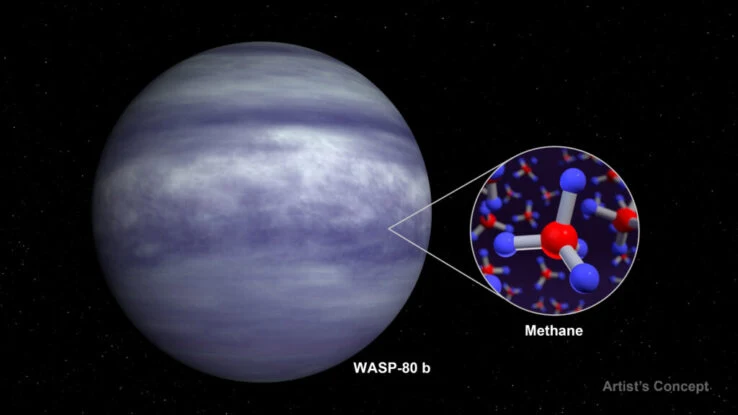Assuming there's one synthetic that causes energy in the quest for biosignatures on different universes, it's methane. It's anything but a sure thing since it has both biotic and abiotic sources.
But finding it in Yet, finding it in an exoplanet's air implies that planet merits a more critical look.
Methane catches logical consideration chiefly due to its brief span in a planetary climate. Methane can't endure starlight for extremely lengthy, essentially not in earthly environments. It surrenders to photodissociation and should be renewed ceaselessly to keep up with its presence in an environment.
On the off chance that a rough planet has a ton of methane, the source must be enormous, making a biotic source likely. On The planet, organic action makes a tremendous measure of methane.
Metabolically, methane is not difficult to make.
When seen with natural eyes, the warm exoplanet WASP-80 b's tone might seem pale blue because of the absence of high-height mists and the presence of air methane recognized by NASA's James Webb Space Telescope. That makes it like the planets Uranus and Neptune in our own planetary group. (NASA.)
Methane is normal in our Nearby planet group, however not really abundant. As may be obvious, it's all abiotic. Processes like serpentinization could make sense of it.
Serpentinization is a characteristic, abiotic process including water, carbon dioxide, and the mineral olivine. Olivine is normal on The planet and is the essential part of our planet's upper mantle. We've likewise tracked down it on the Moon, on Mars, and on certain space rocks.
As of late, the James Webb Space Telescope distinguished methane in the climate of WASP-80b, a gas goliath about half as monstrous as Jupiter. WASP-80b circles a K-type primary grouping star around 1.5 billion years of age. WASP 80 is around 162 light-years away, and WASP-80b is the main planet distinguished around the star up to this point.

This picture shows the deliberate travel range (top) and overshadowing range (lower part) of WASP-80 b from the JWST's NIRCam. In both spectra, there is obvious proof for retention from water and methane. During a travel, the planet passes before the star, and in a travel range, the presence of particles makes the planet's climate block all the more light at specific tones, causing a more profound diminishing at those frequencies. During a shroud, the planet passes behind the star, and in this overshadowing range, particles retain a portion of the planet's discharged light at explicit varieties, prompting a more modest plunge in splendor during the obscuration contrasted with a travel. (BAERI/NASA/Taylor Chime)
Since WASP-80b is a gas goliath, then life is precluded, excepting some limit science fiction situations. Be that as it may, the serpentinization of olivine, the most notable abiotic wellspring of methane, is likewise precluded since WASP-80b is certainly not a rough planet. Yet, it is as yet fascinating to track down it.
That is somewhat in light of the fact that we can now contrast the exoplanet with the methane-containing climates of Uranus and Neptune in our own Planetary group. That can assist us with understanding future methane discoveries better.
WASP-80b is a warm Jupiter. Its temperature is around 550 Celsius (1,025 F; 825 K.) So's in the middle of between hot Jupiters like HD 209458 b (the first traveling exoplanet found) and cold Jupiters, similar to our Planetary group's biggest planet. Our Jupiter is around 112 Celsius (235 F; 125 K.)
The temperature is a significant point. There's a lack of methane recognitions in exoplanet climates, so at this phase of the game, every discovery assumes a significant part in creating air hypothesis and directing subsequent exploration.
WASP-80b's temperature places it in "a fascinating temporary system where balance science models foresee that there ought to be noticeable CH4 and CO/CO2 highlights in the planet's transmission and discharge spectra… " the creators of the exploration make sense of.
WASP-80b is truly near its red small star and requires just three days to circle. Since the planet is up until this point away thus near its star, even the strong JWST can't really see it. All things being equal, space experts utilized the JWST to concentrate on the consolidated light from the star and the planet in travels and obscurations.
There haven't been numerous methane discoveries in that frame of mind by telescopes like the Hubble and the Spitzer, which can both see in infrared, dislike the JWST can. The absence of discoveries drove researchers to foster hypothetical clarifications of how methane could be drained in environments. High metallicity, high inside heat motion, and different reasons were investigated as methane consumption components.

NASA's Explorer 2 shuttle caught these perspectives on Uranus (on the left) and Neptune (on the right) during its flybys of the planets during the 1980s. The two planets have methane in their environments which causes them to seem blue. Be that as it may, they have various sums. Uranus' air holds back around 2.3 percent methane, making it the third most normal part. Neptune contains around 1.5% methane. While that may not appear as though a gigantic distinction, it very well may be a hint to how and where planets like these structure, either in our Planetary group or somewhere else. (NASA/JPL/Caltech)
The scientists likewise say that estimating methane close by water characterizes how and where a planet framed.
"For instance, by estimating how much methane and water in the planet, we can derive the proportion of carbon particles to oxygen molecules," they compose.
"This proportion is supposed to change contingent upon where and when planets structure in their framework." Space experts can utilize this information to decide whether a planet shaped near its star or shaped further away and afterward moved internal.
The JWST probably isn't finished with WASP-80b. This information is from the space telescope's NIRCam instrument. Future MIRI and NIRCam perceptions will test the planet at various frequencies, which ought to recognize other carbon particles like carbon monoxide and carbon dioxide.




